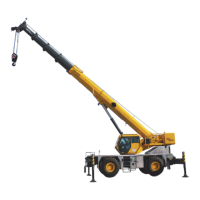HYDRAULIC SYSTEM TMS800E SERVICE MANUAL
2-26
Published 01-29-2014, Control # 496-00
17. If the lift cylinder is not installed, plug the extend hose
(the larger of the two). If lift cylinder is installed, omit this
step and continue to step 18.
18. Start engine and throttle up to full RPM. Select and hold
the cab tilt switch on the superstructure cab right arm
rest in the down position and adjust the load sense relief
valve of the counterweight removal and cab tilt
directional control valve “in” to increase or “out” to
decrease so that a gauge pressure reading of 172 +
4
bar (2500 ± 50 psi) is achieved (see Figure 2-16).
19. Stop engine and remove the diagnostic couplers from
the test nipples.
Procedure B - For Checking/Setting the
Outrigger/Swing Pressures
1. Install a pressure check diagnostic quick disconnect with
gauge onto test nipple at GP7 port of the outrigger
control manifold (see Figure 2-18).
2. Start engine and throttle up to full RPM. Select and hold
either the outrigger “extend or retract” switch on the cab
dash. Adjust the pressure reducing valve integrated in
the outrigger control manifold “in” to increase or “out” to
decrease so that a gauge pressure of 214 +
4 bar (3100
± 50 psi) is achieved (see Figure 2-18).
3. Stop engine. Remove the diagnostic coupler.
Procedure C - For Checking/Setting Air
Conditioner Relief Valve Pressure
1. With engine off, install a pressure check diagnostic
coupler with gauge onto the diagnostic nipple at GP port
of the motor control manifold (see Figure 2-17).
2. Disconnect and cap hose running from the A2 port of the
motor control manifold to hydraulic swivel port #6 (see
Figure 2-17).
3. Start engine, throttle up to 1500 RPM. With the oil cooler
motor off, adjust relief valve in the motor control manifold
“in” to increase or “out” to decrease so that a gauge
pressure of 103 +
4 bar (1500 ± 50 psi) (see
Figure 2-17).
4. Stop engine. Remove diagnostic couplers and re-
connect plumbing.
5. Start engine and throttle up to 1500 rpm. Adjust the relief
valve in the motor control manifold “in” to increase or
“out” to decrease so that a gauge pressure of 221 +
3
bar (3200 ±50 psi) is achieved (see Figure 2-17).
6. Stop engine. Remove diagnostic couplers and
reconnect plumbing.
Procedure D - For Checking/Setting the
Front Steer Pressure
1. Install a pressure check diagnostic quick disconnect with
gauge onto test nipple at GP8 port at the inlet of the
power steering gearbox (see Figure 2-19).
2. Disconnect hose at right hand front steer cylinder (see
Figure 2-20) and plug the hose. Cap or plug the steer
cylinder connection to protect it from contamination.
3. Start engine and throttle up to full RPM. Fully turn the
steering wheel to left or right against axle stop. Adjust
the priority flow relief valve in the pump (see
Figure 2-19) “in” to increase or “out” to decrease so that
a gauge pressure of 150 +
3 bar (2175 ± 50 psi) is
achieved.
4. Stop engine. Remove diagnostic couplers and
reconnect plumbing.
Procedure E - For Checking/Setting Swing
Brake Release Pressure
1. Install a pressure check diagnostic quick disconnect with
gauge onto test nipple at GP4 port of the swing and
accessory manifold (see Figure 2-14). Unplug
connectors containing wire 50 and 1475. Plug connector
containing wire 50 into the solenoid where wire 1475
was connected.
2. Start engine and idle, release swing brake and adjust the
swing brake pressure reducing valve “in” to increase or
“out” to decrease so that a gauge pressure of 18-20 bar
(260-300 psi) is achieved. (see Figure 2-14).
3. If adjustment can’t obtain the setting in step 2, stop
engine and install a pressure check diagnostic quick
disconnect with gauge onto the test nipple at the GP 2 at
the accessory manifold valve (see Figure 2-15). Follow
Procedure G to set and then repeat this step.
Procedure F - For Checking/Setting the Pilot
Supply Pressure
1. With engine off, install a pressure check diagnostic quick
disconnect with gauge onto diagnostic nipple at GP3 of
the swing and accessory manifold (see Figure 2-14).
2. Start engine and run at idle, lower left armrest, depress
and hold the cab tilt lower switch, adjust the controller
pressure reducing valve of the swing and accessory
manifold “in” to increase or “out” to decrease so that the
CAUTION
To prevent pump damage/failure due to heat build up, run
the engine at full RPM in this configuration for a maximum
of 15 seconds to 30 seconds.
Reference Only

